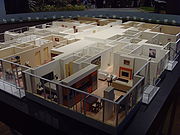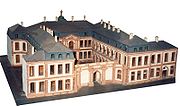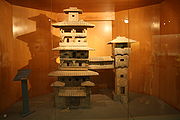
Architectural model
Encyclopedia

Scale model
A scale model is a physical model, a representation or copy of an object that is larger or smaller than the actual size of the object, which seeks to maintain the relative proportions of the physical size of the original object. Very often the scale model is used as a guide to making the object in...
, tangible (also called sometimes physical) representation of a structure built to study aspects of an architectural design
Architecture
Architecture is both the process and product of planning, designing and construction. Architectural works, in the material form of buildings, are often perceived as cultural and political symbols and as works of art...
or to communicate design ideas to clients, committees, and the general public. Architectural models are a tool which may be used for show, presentation, fundraising, obtaining permits, and sale purposes.
Rough study models can be made quickly using cardboard, wooden blocks, polystyrene, foam, foam boards and other materials. Such models are an efficient tool for three-dimensional understanding of a design, used by architects, interior designers and exhibit designers. For a highly detailed presentation model, architects would employ a professional model maker or model making company.
Purpose
Architectural models are used by architects for a range of purposes -- Quick, ad hocAd hocAd hoc is a Latin phrase meaning "for this". It generally signifies a solution designed for a specific problem or task, non-generalizable, and not intended to be able to be adapted to other purposes. Compare A priori....
models are sometimes made to study the interaction of volumes, or to get an idea of how they look from different angles. Designing a building using rough models can be a very open-ended and practical method of exploring ideas.
- Models are an efficient method for exhibiting and selling a design. Many people, including developers and would-be house buyers, cannot visualise a design in three dimensions (3-D) from two-dimensional (2-D) drawings. An architect may employ small-scale physical models, or digital computer models, to help explain the ideas.
- A model may be useful in explaining a complicated or unusual design to the building team, or as a focus for discussion between the design teams such as architects, engineers and town planners.
- Models are also used as show pieces, for instance as a feature in the reception of a prestigious building, or as part of a museum exhibition (for example scale replicas of historical buildings).
Types




- Exterior models are models of buildings which usually include some landscaping or civic spaces around the building.
- Interior models are models showing interior space planning, finishes, colors, furniture and beautification.
- Landscaping design models are models of landscape design and development representing features such as walkways, small bridges, pergolas, vegetation patterns and beautification. Landscaping design models usually represent public spaces and may, in some cases, include buildings as well.
- Urban models are models typically built at a much smaller scale (starting from 1:500 and less, 1:700, 1:1000, 1:1200, 1:2000, 1:20 000), representing several city blocks, even a whole town or village, large resort, campus, industrial facility, military base and so on. Urban models are a vital tool for town/city planning and development.
- Engineering and construction models show isolated building/structure elements and components and their interaction.
Virtual modelling
Over the last few decades, detailed construction has been increasingly designed in CAD (Computer Aided Design) systems. The technology is improving rapidly. Early virtual modelling involved the fixing of arbitrary lines and points in virtual space, mainly to produce technical drawings. Modern packages include advanced features such as databases of components, automated engineering calculations, visual fly-throughs, dynamic reflections, and accurate textures and colours.While virtual tour
Virtual Tour
A virtual tour is a simulation of an existing location, usually composed of a sequence of video images. They also may use other multimedia elements such as sound effects, music, narration, and text....
s are undoubtedly useful, they are still limited to images on a computer screen and lack the sensory impact, or qualia
Qualia
Qualia , singular "quale" , from a Latin word meaning for "what sort" or "what kind," is a term used in philosophy to refer to subjective conscious experiences as 'raw feels'. Examples of qualia are the pain of a headache, the taste of wine, the experience of taking a recreational drug, or the...
, of a physical model.
Materials
Common materials used for centuries in architectural model building were card stock, balsa wood, basswood and other woods. Modern professional architectural model builders are taking advantage of twenty-first century materials, such as Taskboard, a variety of plastics, wooden and wooden-plastic composites, foams, foam boardFoamcore
Foam core or Foam board is a very strong, lightweight and easily cut material used for the mounting of photographic prints, as backing in picture framing, in 3D design, and in painting. It is also in a material category referred to as "Paper-faced Foam Board"...
and urethane compounds.
A number of companies produce ready-made pieces for structural components (e.g. girders, beams), siding, furniture, figures (people), vehicles, trees, bushes and other features which are found in the models. Features such as vehicles, people figurines, trees, street lights and other are called "scenery elements" and serve not only to beautify the model, but also to help the observer to obtain a correct feel of scale and proportions represented by the model. Increasingly, rapid prototyping
Rapid prototyping
Rapid prototyping is the automatic construction of physical objects using additive manufacturing technology. The first techniques for rapid prototyping became available in the late 1980s and were used to produce models and prototype parts. Today, they are used for a much wider range of applications...
and solid freeform fabrication ('3D printing') are used to automatically construct models straight from CAD
Computer-aided design
Computer-aided design , also known as computer-aided design and drafting , is the use of computer technology for the process of design and design-documentation. Computer Aided Drafting describes the process of drafting with a computer...
plans.
The challenge with using these tools lies in the CAD file format. The majority of 3D printers accept the stereolithography
Stereolithography
Stereolithography is an additive manufacturing technology for producing models, prototypes, patterns, and in some cases, production parts.-Technology description:...
(.STL for short) file format, which is basically a mesh that wraps around the object in 3-dimensions. It helps to visualize this as a bag of oranges wrapped in a mesh bag. If there is a "tear" in the bag, the oranges will spill out. This is similar to what happens when an STL file is not cleanly produced and prematurely sent to a 3D printer. Clean STL files are a major challenge for architecture models produced using this technology.
Other rapid prototyping technology, also CAD based, which become very useful for architectural model making is CNC carving. Large CNC carving plotters are able to carve out of high density foam boards up to 10' x 4' topography for architectural or urban model.
Recently a small profile CNC carving plotter has been released which allows low-cost rapid prototyping of buildings and topography from other file types, including Google SketchUp's KMZ format and ArcGIS.
Scales
Architectural models are being constructed at much smaller scaleScale (ratio)
The scale ratio of some sort of model which represents an original proportionally is the ratio of a linear dimension of the model to the same dimension of the original. Examples include a 3-dimensional scale model of a building or the scale drawings of the elevations or plans of a building. In such...
than their 1:1 counterpart. Standard architectural scales are different, although some of them are close to the standard scales acknowledged in the model/hobby industry. Such similarities allow us to provide high quality scenery elements for architectural models. Sometimes model railroad scales such as 1:160 and 1:87 are used due to ready availability of commercial figures, vehicles and trees in those scales, and models of large buildings are most often built in approximately that range of scales due to size considerations. Models representing 1-2 buildings and a modest piece of surrounding landscape may be built at a larger scale such as 1:50 or even 1:24. Here is a useful *Scale Guide to obtain more information about standard architectural scales and to help with scale selection.
The scales and their architectural use is broadly as follows:
- 1:1 Full (or real) size for details
- 1:2 Details
- 1:5 Details
- 1:10 Interior spaces/furniture
- 1:20 Interior spaces/furniture
- 1:50 Interior spaces/detailed floor plans/different floor levels
- 1:100 Building plans/layouts
- 1:500 Building layouts/site plans
- 1:1000 Urban scale for site or location plans
- 1:1250 Site plans
- 1:2500 Site plans/city maps
Architects usually employ a professional model maker
Model maker
A model maker is a professional craftsperson who creates a 3 dimensional representation of a design or concept. Most products in use and in development today first take form as a model. This "model" may be an exacting duplicate of the future design or a simple mock-up of the general shape or concept...
or model making company to create such models.
Paper Architectural Model

Origami
is the traditional Japanese art of paper folding, which started in the 17th century AD at the latest and was popularized outside Japan in the mid-1900s. It has since then evolved into a modern art form...
. This takes a high level of skill in order to accomplish in a proper manner.*http://www.minibldg.com
See also
- Scale modelScale modelA scale model is a physical model, a representation or copy of an object that is larger or smaller than the actual size of the object, which seeks to maintain the relative proportions of the physical size of the original object. Very often the scale model is used as a guide to making the object in...
- MaquetteMaquetteA maquette is a small scale model or rough draft of an unfinished architectural work or a sculpture...
- Architectural renderingArchitectural renderingArchitectural rendering, or architectural illustration, is the art of creating two-dimensional images or animations showing the attributes of a proposed architectural design.-Computer-generated renderings:...
- Building modelBuilding modelBuilding models are scale models of structures. They are commonly used in model railroading as well as wargaming and diorama making. Architectural models are also made to demonstrate and promote buildings before they are constructed....
(non-architectural) - Origamic ArchitectureOrigamic architectureOrigamic architecture involves the three-dimensional reproduction of architecture, geometric patterns, everyday objects, or other images, on various scales, using cut-out and folded paper, usually thin paperboard. Visually, these creations are comparable to intricate 'pop-ups', indeed, some works...
(OA)
External links
- Association of Professional Model Makers (APMM)
- DO HERE: Architectural Modeling Rendering Visualization Illustration
- Dolls House Theatre The first performing model theatre in the word dedicated to keeping "theatre alive".
- Construction scale models ( www.lasmaquetas.com ) Architectural and monuments scale models (Spanish)

